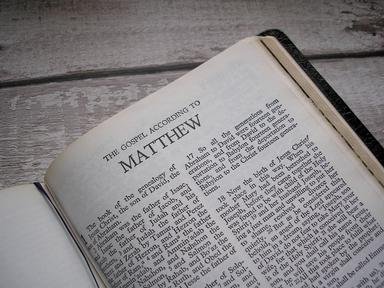Quiz Answer Key and Fun Facts
1. Matthew begins his gospel by providing a genealogy for Jesus that traces his family tree back to which of these biblical characters?
2. "Now when he saw the crowds, he went up on a mountainside and sat down." (Matthew 5 v. 1)
Which title has traditionally been given to the body of teaching that follows this verse?
3. The gospel writers emphasise that one of Jesus' major themes was preaching that God's kingdom is very near. Matthew is no exception but chooses, mostly, to use which alternative phrase?
4. Matthew, Mark and Luke all record an incident where Jesus calls Matthew from his work as a tax collector. Mark and Luke, however, call Matthew by a different name. What is this name?
5. "For verily I say unto you, Till heaven and earth pass, one jot or one tittle shall in no wise pass from the law, till all be fulfilled." (Matthew 5 v. 18 - King James translation)
What are jots and tittles?
6. Jesus replied, "Blessed are you, Simon son of Jonah, for this was not revealed to you by man, but by my Father in heaven. And I tell you that you are Peter, and on this rock I will build my ______." (Matthew 16 v. 17-18)
Which of these words completes the quote?
7. Which group of people does Jesus criticize by describing them as whitewashed tombs - sparkling on the outside but dead on the inside?
8. Which of these parables, about being ready for the second coming of Jesus, is only found in the gospel of Matthew?
9. Matthew is the only one of the gospel writers to record an unusual occurrence that accompanied Jesus' crucifixion. Which of these does he record?
10. Which of these are Jesus' last recorded words in Matthew's gospel?
Source: Author
glendathecat
This quiz was reviewed by FunTrivia editor
CellarDoor before going online.
Any errors found in FunTrivia content are routinely corrected through our feedback system.

